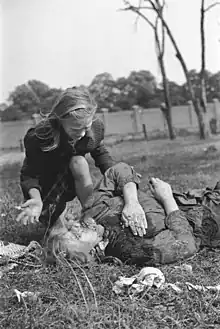痛苦
痛苦(suffering)是構成情感現象負面效價(Valence)的基本要素。痛苦的反面是快樂或幸福等。與個人對傷害或傷害威脅的感知有關。[1]

1939年9月,波蘭華沙,12岁的波兰女孩卡齐米拉·米卡在她的姐姐安娜(14岁)旁邊,後者在德国空军的空袭中丧生。
摄影师朱利安·布赖恩描述当时的情景:“当我们开车经过城镇边缘的一片小田地时,我们目睹了這场悲劇,这是最令人难以置信的几分钟。七名妇女一直在地里挖土豆————他们所在的地区没有面粉,他们急需食物。突然两架德国飞机不知从哪里冒出来,向两百码外的一所小房子投下两枚炸弹。房子里的两名妇女被炸死。挖土豆的人平躺着地面上,希望不被注意。轰炸机离开后,妇女们回到工作岗位。她们必须吃东西。
但纳粹飞行员对他们的轟炸并不满意。几分钟后,他们回来俯冲到离地面不到200英尺的地方,这次用机枪扫射。七名妇女中有两名被杀。当我在给尸体拍照时,一个十岁的小女孩跑过来,站在一具遺體旁边目瞪口呆。这个女人是她的姐姐。孩子从未见过死亡,不明白为什么姐姐不再跟她说话……
摄影师朱利安·布赖恩描述当时的情景:“当我们开车经过城镇边缘的一片小田地时,我们目睹了這场悲劇,这是最令人难以置信的几分钟。七名妇女一直在地里挖土豆————他们所在的地区没有面粉,他们急需食物。突然两架德国飞机不知从哪里冒出来,向两百码外的一所小房子投下两枚炸弹。房子里的两名妇女被炸死。挖土豆的人平躺着地面上,希望不被注意。轰炸机离开后,妇女们回到工作岗位。她们必须吃东西。
但纳粹飞行员对他们的轟炸并不满意。几分钟后,他们回来俯冲到离地面不到200英尺的地方,这次用机枪扫射。七名妇女中有两名被杀。当我在给尸体拍照时,一个十岁的小女孩跑过来,站在一具遺體旁边目瞪口呆。这个女人是她的姐姐。孩子从未见过死亡,不明白为什么姐姐不再跟她说话……
痛苦通常被歸類為身體上的[2]或心智上的。[3] 它可能有各種程度的強度,從輕微到無法忍受。持續時間長度和發生頻率的因素通常與強度因素相結合。受苦者或其他人對痛苦的態度可能有很大差異,這取決於它被認為是可以避免或不可避免、有用或無用、值得或不值得的。
苦在各種生物的生命中以多種方式發生,經常是戲劇性的。因此,人類活動的許多領域都與痛苦的某些方面有關。這些方面可能包括痛苦的性質、過程、起源和原因和意義、相關的個人、社會和文化行為[4]、治療、管理和使用。
痛苦與人類的意識有關,而且經常伴隨著過去的經驗。
造成痛苦的常見示例有:
字源
在漢語中,痛,是指肉體上的疼痛,而苦,則是來自於味覺上的苦澀感覺,將這兩種感覺結合,就形成痛苦這個詞。痛苦是一個概括性的形容語,肉體上產生的疼痛感受,可以稱為痛苦,而心靈上的煩惱掙扎,也可以稱為痛苦。
宗教對「苦」的詮釋
參考資料
- For instance, Wayne Hudson in Historicizing Suffering, Chapters, Springer, 2012) : "According to the standard account suffering is a universal human experience described as a negative basic feeling or emotion that involves a subjective character of unpleasantness, aversion, harm or threat of harm to body or mind (Spelman 1997; Cassell 1991)."
- Examples of physical suffering: pain of various types, excessive heat, excessive cold, itching, hunger, thirst, nausea, air hunger, sleep deprivation. . [September 11, 2008]. (原始内容存档于September 26, 2008).. [2008-09-11]. (原始内容存档于2007-10-28). Other examples are given by L. W. Sumner, on p. 103 of Welfare, Happiness, and Ethics (页面存档备份,存于): "Think for a moment of the many physical symptoms which, when persistent, can make our lives miserable: nausea, hiccups, sneezing, dizziness, disorientation, loss of balance, itching, 'pins and needles', 'restless legs', tics, twitching, fatigue, difficulty in breathing, and so on."
- Mental suffering can also be called psychological or emotional (see Psychological pain). Examples of mental suffering: depression (mood) / hopelessness, grief, sadness / loneliness / heartbreak, disgust, irritation, anger, jealousy, envy, craving or yearning, frustration, anguish, angst, fear, anxiety / panic, shame / guilt, regret, embarrassment / humiliation, restlessness.
- Eggerman, Panter Brick, Mark, Catherine. . Social Science & Medicine. 2010, 71 (1): 71–83. PMC 3125115
 . PMID 20452111. doi:10.1016/j.socscimed.2010.03.023.
. PMID 20452111. doi:10.1016/j.socscimed.2010.03.023.
This article is issued from Wikipedia. The text is licensed under Creative Commons - Attribution - Sharealike. Additional terms may apply for the media files.